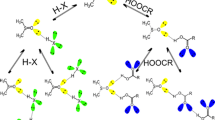Abstract
The species UO2(DMSO) 2+5 is shown from1H NMR studies to be the predominant dioxouranium(VI) species existing in dilute anhydrous acetonedimethyl sulfoxide (DMSO) solutions, and this result is compared with data reported for the analogous water-acetone-dimethyl sulfoxide system. Complete line-shape analyses of exchange-modified1H NMR line shapes indicate that the mechanism for DMSO exchange on UO2(DMSO) 2+5 is probably of theD orI D type. A typical set of rate parameters arek ex (260°K) =273±14 sec−1, ΔH #=38.9±0.5 kJ-mole−1, and ΔS #=−47.5±1.8 J-oK−1-mole−1 for a solution in which [UO2(DMSO)5 2+], [DMSO], and [d 6 acetone] are, respectively, 0.01155, 0.0875, and 13.00 moles-dm−3.
Similar content being viewed by others
References
R. P. Bowen, S. F. Lincoln, and E. H. Williams,J. Magn. Reson. 19, 243 (1975).
R. P. Bowen, S. F. Lincoln, and E. H. Williams,Inorg Chem. 15, 2126 (1976).
J. Crea, S. F. Lincoln, and E. H. Williams,Aust. J. Chem. 29, 2183 (1976).
J. Crea, R. Diguisto, S. F. Lincoln, and E. H. Williams,Inorg. Chem. 16, 2825 (1977).
A. Fratiello, G. A. Vidulich, C. Cheng, and V. Kubo,J. Solution Chem. 1, 433 (1972).
A. Fratiello, V. Kubo, and R. E. Schuster,Inorg. Chem. 10, 744 (1971).
N. W. Alcock and S. Esperàs,J. Chem. Soc. Dalton Trans., 893 (1977).
N. M. Karayannis, C. Owens, L. L. Pytelwski, and M. M. Labes,J. Inorg. Nucl. Chem. 31, 2059 (1969).
P. W. N. M. van Leeuwen and W. L. Groenveld,Inorg. Nucl. Chem. Lett. 3, 145. (1967).
H. D. Burrows and T. J. Kemp,Chem. Soc. Rev. 3, 139 (1974).
A. I. Vogel,Quantitative Inorganic Analysis, 3rd ed. (Longmans, Green and Co., London, 1961), p. 702.
S. F. Lincoln,Coord. Chem. Rev. 6, 309 (1971).
A. Fratiello,Prog. Inorg. Chem. 17, 57 (1972).
F. Toma, M. Villemin, and J. M. Thiery,J. Phys. Chem. 77, 1294 (1973).
J. Crea, S. F. Lincoln, and R. J. West,Aust. J. Chem. 26, 1227 (1973).
U. Mayer and V. Gutmann,Struct. Bonding,12, 113 (1972).
L. R. Nassimbeni and A. L. Rodgers,Cryst. Struct. Commun. 5, 301 (1976).
C. H. Langford and H. B. Gray, inLigand Substitution Processes, (W. A. Benjamin, New York, 1966).
R. M. Fuoss,J. Am. Chem. Soc. 80, 5059 (1958).
K. Kustin and J. Swinehart,Prog. Inorg. Chem. 13, 107 (1970).
Author information
Authors and Affiliations
Rights and permissions
About this article
Cite this article
Honan, G.J., Lincoln, S.F. & Williams, E.H. The solvation of the dioxouranium(VI) ion by dimethyl sulfoxide. J Solution Chem 7, 443–451 (1978). https://doi.org/10.1007/BF00646114
Received:
Revised:
Issue Date:
DOI: https://doi.org/10.1007/BF00646114




